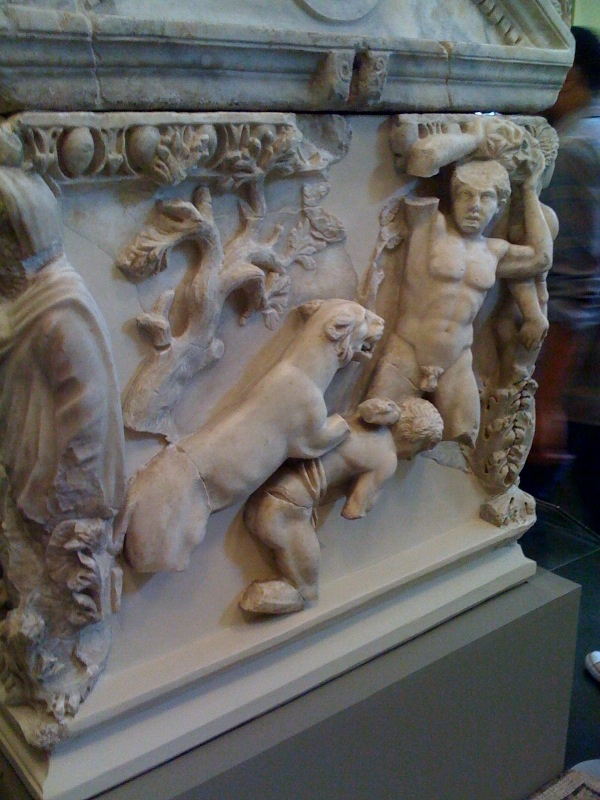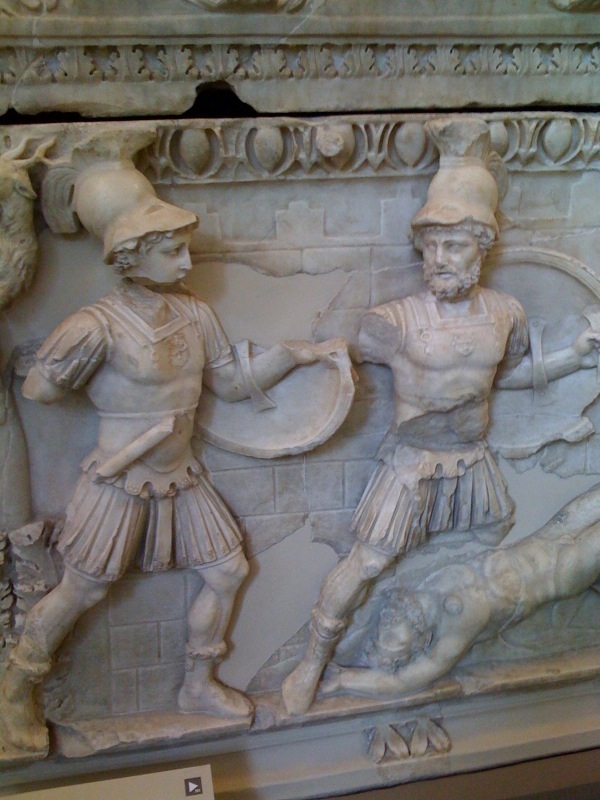Museum Artifact 9/29/08 Roman Sarcophagus: A Portrait Honoring Death and Culture
Burials and beliefs of an after life in Ancient Rome changed significantly as outside cultural influences affected the culture of Rome. Through their transition from the procedure of cremation to the use of decorated sarcophagi, Roman beliefs in the significance and importance of deaths and an afterlife are tracked. Beginning in the second century A.D., the Romans terminated their use of cremation and began inhumation burials. These evolving ideas were influenced by Greek and Etruscan culture. The sarcophagi were made of several different materials such as wood, lead, and stone. The higher classes of society as well as people of status used a marble sarcophagus, viewed as the most luxurious material. The sarcophagi of Ancient Rome were used to honor and remember the lives of the deceased through detailed and symbolic decorations. To the Romans, the sarcophagus came to represent much more than a home to a body. It depicted cultural ideas, elements, and themes through iconography in the veneration of death and the continuance of the after life. This marble sarcophagus, said to be from Pamphylia, depicts scenes of bravery and battle from the Trojan War as well as several cultural symbols and motifs.
This marble sarcophagus was intricately decorated on all four sides and lid. Depending on the position of the sarcophagus different sides were decorated. Most often sarcophagi were placed along or inside a wall; therefore, only the front and visible sides were decorated. However, because all sides of this sarcophagus were decorated, the sarcophagus was most likely placed in the center of a room for display. The deceased body was therefore that of a high-status figure that was honored by much of the society. The shape of the sarcophagus also transcends the importance of the deceased body. The lid resembles a roof, imitating the architecture of a temple or place of worship. Flat lids often depicted the portrait of the deceased; however, this lid is decorated with intricate detail lining the outside and corners. Above the decorative lining, is a lining of multiple roaring lion heads. The symbolism of lion heads was a historical funerary tradition that the fierce animal would guard the tomb and body. The detailed designs of the lid are on most corners and line the bottom. These designs resemble the style of a Greek Corinthian column with leaves and scrolls.
The Roman interest in Greek culture is reflected in several ways in sarcophagus design. Greek mythology was a common theme of decoration. The Trojan War, believed to have taken place between the thirteenth and twelfth centuries B.C. and depicted on this sarcophagus, is one the most important and written about events in Greek mythology. However, this is one of few sarcophagi to display scenes of the war. Several important people from the myth such as Achilles, Trojan Prince Hektor, Goddess Athena, Hector’s Father King Priam, and Hector’s wife Andromache are depicted extremely realistically into the sides of this sarcophagus. At the far left of one of the long sides, Achilles and Prince Hektor are shown battling. Their facial expressions such as Hektor’s beard, and fighting uniforms are extremely detailed. Easily seen are the pleats of their uniforms, shields, armor, and the muscle definition of the two men.
This side reads like a story or narrative from left to right. Directly to the right of their battle, Achilles is seen dragging a nude-looking Hektor from his horse-drawn chariot. There are several people in the background watching this event such as Goddess Athena. The most prominent figures watching are carved out in the foreground. In the foreground are King Priam and Hector’s wife Adromache who is sitting down in the right corner. Adromache is adorned in several layers of elaborately detailed fabric along with a head drapery. She is also depicted with a sorrowful facial expression. Her face is the only one that shows any slight emotion or expression. All of the carved figures are proportionally equal. The only noticeably larger human body is that of Adromache sitting down. Continuing right, on one end of the sarcophagus, there are two male nude bodies. Each of the bodies is extremely detailed, muscular, and draped with fabric across their shoulders and chest. Between the two men is what appears to be Greek column—continuing the Greek cultural theme.
The significance of depicting a battle scene and famous war represent the importance of bravery and virtue to the Romans, but also most likely to the body of the sarcophagus. The decoration on a sarcophagus reflected the attributes and life of the deceased that inhabits the tomb. Significant life events such as professions, weddings, festivals, hunting and battles and everyday cultural aspects such as nudity, nature and animals were common themes in the carvings of sarcophagi. Because battle scenes and valor mythological characters such as Achilles dominate the carvings of this sarcophagus, the bravery and courage of the deceased was recognized and honored. The symbolism on sarcophagi not only served the purpose of honoring attributes of the body but also elevating and maintaining the status of the deceased.
On the opposite long side of the sarcophagus is another battle scene. On the far left corner is a young, nude man. He is holding a woven basket full of fruits. The complexity and stratification of society are portrayed, as there are figures from ranging social classes, such as this servant, depicted throughout the scenes. The man with the basket seems to play no role in the battling scene depicted directly right of him. Next to the man is a battle between two lions and three young, nude boys with wings resembling angels. It is unclear as to which side is dominating the battle. Neither group seems to be in a significant amount of pain or loss. This is interesting in contrast to the blatant victory of Achilles on the opposite side. The strong cultural themes of nudity, violence, myth, and animals are repeated in this sequence. The angel’s bodies are much less muscular and detailed than the other male bodies, and may also represent a religious aspect of the culture. Also, lions are used again in a form of bravery and protection. It is interesting to note the proportion of the angels to the full-grown lions. Perhaps because the angels are mythical or powerful figures they are depicted just as large as a lion.
The other end of the sarcophagus portrays another battle scene with lions. However, instead of angels, the lions are fighting full-grown men. Again the men are nude and extremely muscular. One man, huddled on the ground, seems to have been hurt by the lion and is in need of protection from the other man. The second man is hurtling a large rock at the ferocious lion bounding towards him. In contrast, to the battle with the angels, it is clear in this narrative that the lion has successfully injured at least one of the men, and the scene is much more violent. In the background, there is a detailed carving of a tree. The tree has a large trunk and blooming branches with leaves. The importance of nature is illustrated through the background of this battle scene. The tree is almost as large and prominent as one of the male figures in the scene, and takes up a significant amount of space in the scene. Again, themes of nature, animals, and battles are depicted.
A Roman sarcophagus was much more than solely a resting place of a body. It came to represent culture, honor, and a pictorial portrait of the deceased. This marble sarcophagus represented several icons and symbols of its time period. The carvings across each side depicted a different narrative that related to several cultural themes. The violent battle scenes, animals, nature, Greek influences, and religious figures all work to illustrate the bravery of the deceased body, but also represent significant aspects of the Roman culture.


